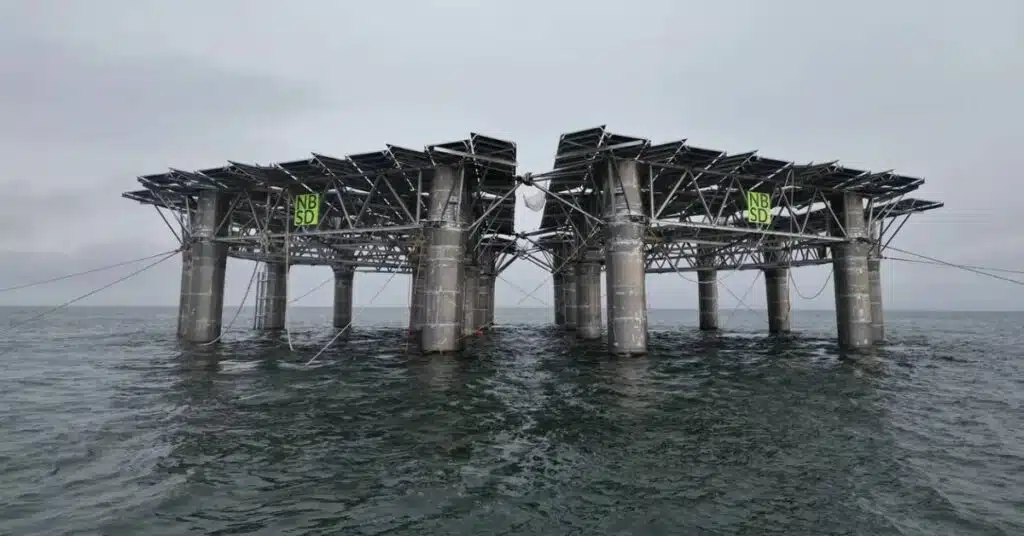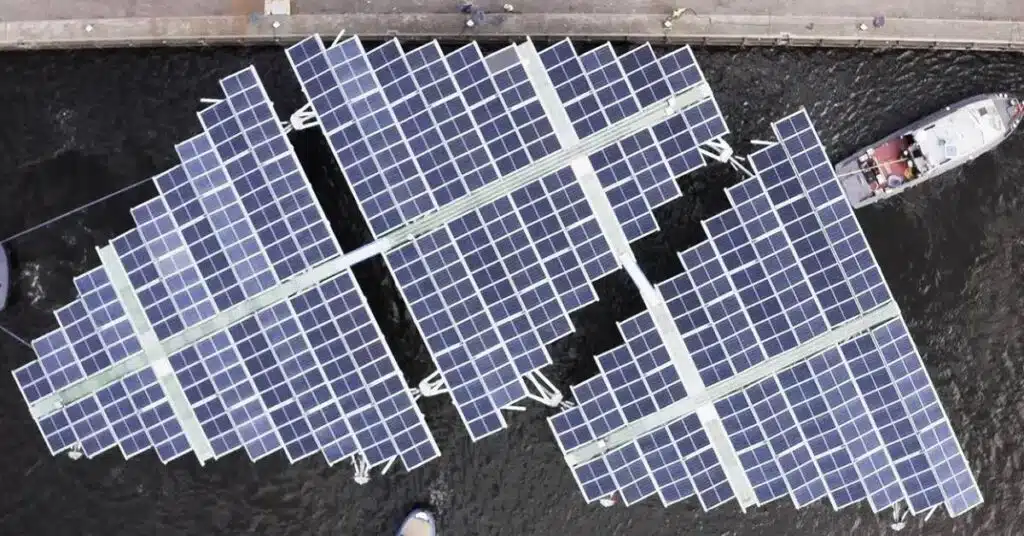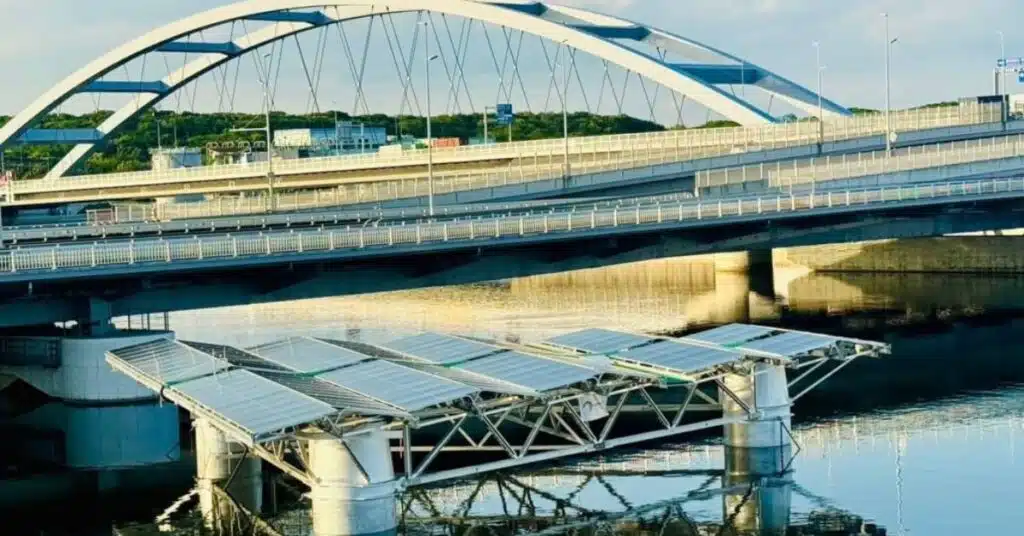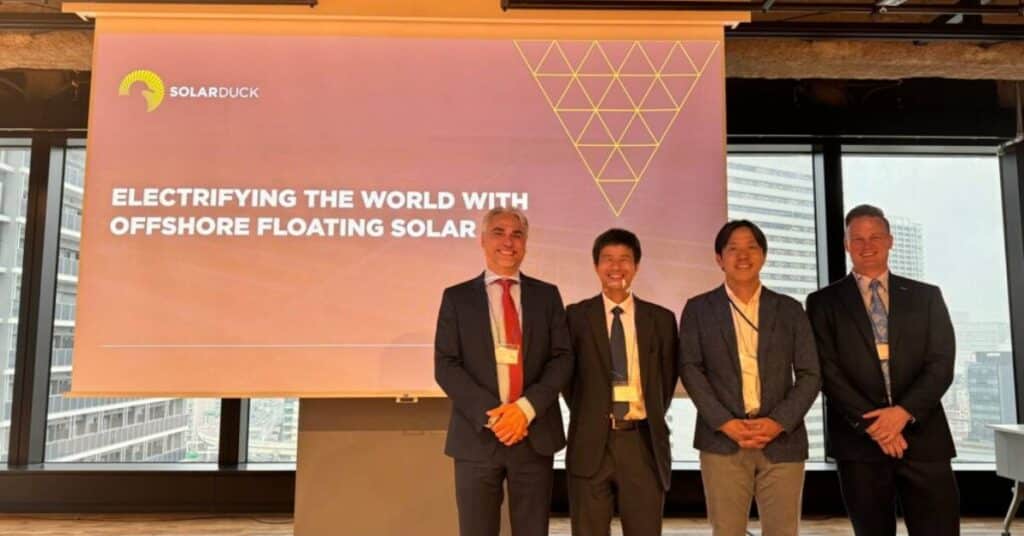How SolarDuck is powering the next wave of renewable energy
April 10, 2025
Transitioning to renewable energy sources while coping with an increasing energy demand has emerged as one of the immediate challenges of the 21st century. Driven by global population growth, urbanisation, extreme weather events, digitalisation (data centres, AI, blockchain), and electrification (EVs, smart grids), the challenge of energy demand is immense and multifaceted. While the transition to renewable energy like solar, wind, and hydropower is expanding, the shift to renewables is both urgent and complex. One startup trying to solve the complexity associated with solar energy is SolarDuck.
From its origin story to how it aims to accelerate the energy transition, everything about SolarDuck is interesting. Founded by Koen Burgers, Don Hoogendoorn, Olaf de Swart, Ewoud Huiskamp, and Harry Post in 2019, Rotterdam-based SolarDuck develops and deploys offshore floating solar energy solutions. The idea, Burgers tells me, originated from an innovation request that crossed his desk while he was working at Damen Shipyards.
“When you work for Damen, you are also exposed to the world outside the Netherlands,” he says, before adding, “The Netherlands is prone to offshore wind, but the wind isn’t evident everywhere in the world.”
Such places are often very sunny, which makes solar energy a great alternative to fossil fuel. However, these places are typically heavily urbanised and lack the space of dry land to erect large scale solar plants. This situation led to SolarDuck following other energy providers like oil & gas and later wind, who all started on land and moved out to sea, to generate the energy.
Burgers has an old-school charm where he effortlessly switches from a founder being poetic about his startup to a veteran business leader showing why the business makes sense. He is also honest enough to admit that the idea wasn’t his own but was already there, but with his co-founders, SolarDuck was able to work on it with help from Damen Shipyard.

One of the common concerns with renewable energy generation at sea is dealing with this harsh offshore environment. Burgers is acutely aware of this challenge and SolarDuck technology is specifically designed to withstand these conditions. At the same time, Burgers argues not every sea is as hostile as the North Sea, where they are running their largest pilot project.
Based out of the North Sea, this heavy beast laboratory serves as the test bed for everything. He adds that places like the Singapore Straits or the inland sea in Japan aren’t as hostile as the North Sea. “In more sheltered waters in Japan, sometimes you have a typhoon hitting it, but in terms of wave heights, it’s relatively limited.”
So, you have to design a structure capable of coping with a hostile environment, and Burgers argues that is SolarDuck’s core expertise. The Dutch startup has a product range for heavier and lighter duty areas and accounts for adverse effects by elevating the PV system.
SolarDuck has designed triangular-shaped platforms that connect to look like a circle from the top. This triangular shape allows for better wave handling abilities than a square shape, and when multiple triangular-shaped platforms are connected, they act like a carpet in water. With a steep increase in efficiency and decrease in price per watt in the solar panel industry, SolarDuck’s technology is not only becoming accessible but also competitive.
It is not only the lack of space on dry land that forced SolarDuck to bring solar energy to the offshore environment but also because of its inherent advantage. One such advantage, Burgers explains, is the cooling effect. He says solar panels become dramatically less efficient when they are hot, and with offshore solar installation, they have to worry less about this problem.
The offshore environment also offers the benefit of utilising the albedo effect, which defines the reflexivity of a surface. A higher albedo effect means the surface can reflect more sunlight, while a lower value means the surface is capable of absorbing more sunlight.
By using bifacial solar panels, Burgers says they can maximise the efficiency of their design, resulting in a flatter output curve. The competitiveness of solar energy is only increasing with innovations hitting the market, such as perovskite solar.
“So what we do is prepare ourselves for the already ongoing boom in,” he quips.

SolarDuck believes that the world can be powered by solar energy, but to get there, you will need to build infrastructure such as extended grids and (offshore) transmission hubs. For this to happen, Burgers argues that the relevance of offshore solar will initially mainly be in countries where wind isn’t evident or countries with limited dry space for installing large solar projects. This is to ensure the cost per watt is sustainable.
Next, Burgers adds that SolarDuck and the Dutch government have identified that both wind and solar energy are complementary to each other. He says both use infrastructure which is designed for peak output, and often this peak is not attained with wind energy and this can be complemented by solar energy.
“You don’t have to invest in infrastructure,” he says, before adding, “it’s about getting extra kilowatt-hours from the same infrastructure by combining wind and solar resources.”
In many places closer to the equator, there is no wind resource, Burgers says offshore solar will be cheaper than offshore wind. To make this effective, there is an increasing need to integrate storage in the product offering.
In the case of SolarDuck, they have designed the floating solar installation in such a way that energy storage solutions can be added. In the short term, he sees battery storage as a viable solution, and for the longer term, this could also entail compressed energy storage.
With its floating solar installation, SolarDuck has certified its technology, its design acumen, and by complementing the solution with wind energy, it looks like a viable solution. “If you look at energy prices, we can supply energy at very competitive rates, especially in places where energy is often expensive,” argues Burgers.
He says a common misconception about renewable energy is that it makes the energy supply pricier. In reality, he adds that it is the contrary and says German energy prices have fallen by a third from their October 2022 peak with the inclusion of renewable energy.
“Renewable energy decreases price, increases energy independence, and makes energy infrastructure more robust.”
With its offshore floating solar, SolarDuck has developed and deployed a renewable solar energy system that does not suffer from the bottlenecks of offshore wind energy. It can be deployed quickly and flexibly, and can remain in service for between 20 and 30 years.
The technology is so robust that the startup is already moving beyond its North Sea pilot. It recently completed the installation of Japan’s first offshore floating solar photovoltaic (OFPV) power plant and successfully installed offshore floating solar pilot Merganser off the Dutch coast.

SolarDuck is a quintessential product of Rotterdam, which Burgers calls the capital of Maritime Europe and the offshore industry. With TU Delft and other educational institutes, he says the city is a concentration of people, knowledge, and competencies, which is comparable to the Brainport region in Eindhoven, which has become a hub for the high-tech industry.
If Silicon Valley stands out for its software acumen and Amsterdam for its finance and software startups, Rotterdam could become the household name for marine tech startups in the Netherlands. However, it is not without limitations, and the primary one being offering connections and financing options.
“We can do better there,” he says, adding, “We are too afraid of risks still.”
This, he says, is entirely different from Silicon Valley. However, he argues, the Netherlands is the best region for developing this technology. “It’s very internationally focused, and at the end of the day, the whole of the Netherlands is just a village.”
For instance, through Up!Rotterdam, Burgers tells me that Lars Crama and team have built an ecosystem conducive to the success of startups like SolarDuck. However, he believes there is a need to understand how the trajectory is different for deep tech and infra tech startups compared to software startups. “We can learn from each other in terms of processes, but the type of investors are different, the timelines are different, the scaling nature is different,” he quips.
Since it was founded, SolarDuck has raised €19M, which may seem like a paltry amount for an energy transition company, but it has been intentional. “I would always like to raise more,” says Burgers, before explaining that they continue to operate like a bootstrapped startup since that allows them to develop their technology and scale their business model.
According to the State of Dutch Tech report by Techleap, early-stage funding remains a big challenge for Dutch startups, and this challenge is even bigger for startups in deep tech and SciTech. He acknowledges this challenge and says that infrastructure financing or early-stage infrastructure companies are not popular among investors.
“Raising money in our industry is difficult, especially in the early stages, and we have been lucky to have good investors, primarily in northwest Europe,” he adds.

Burgers has absolute clarity on what he aims to achieve with SolarDuck. He says their approach to success is “think big and start small,” and it would be false to say they have started small, since their pilot project in the North Sea is in a league of its own. By small, he means projects capable of producing half a megawatt of solar power. Now, the Dutch startup is working to scale its projects and include building large-scale projects in 2028 and beyond.
“We will be building smaller scale, but already have commercial products. We can serve multiple market segments with our technology. Growth in plant sizes will continue in the later stage of the decade or beginning of next decade,” he adds.
Renewable energy has already made a big dent in terms of energy supply in Britain, China, and the European Union and by the end of the decade, Burgers sees the industry taking off with projects sized between 5MW and 50MW. He sees a point where offshore solar projects will grow to 100 to 250 megawatts and beyond, and solar becoming parts of the green energy supply mix.
“You already see a tremendous rate of increase in solar deployment. So they’re over 600 gigawatts already in one year,” he explains.
To reach the scale that SolarDuck is aiming to achieve, Burgers says they will see rapid growth in operations. With cheap access to solar panels and developers delivering efficiency, it will all come down to integrators like SolarDuck to deliver on the solar promise.
Burgers is certain about one thing: no one form of renewable energy will dominate the energy ecosystem. He says it will be a mix of solar, wind, tidal and nuclear and – for the foreseeable future also oil and gas will remain part of our energy mix.
Search
RECENT PRESS RELEASES
Related Post




